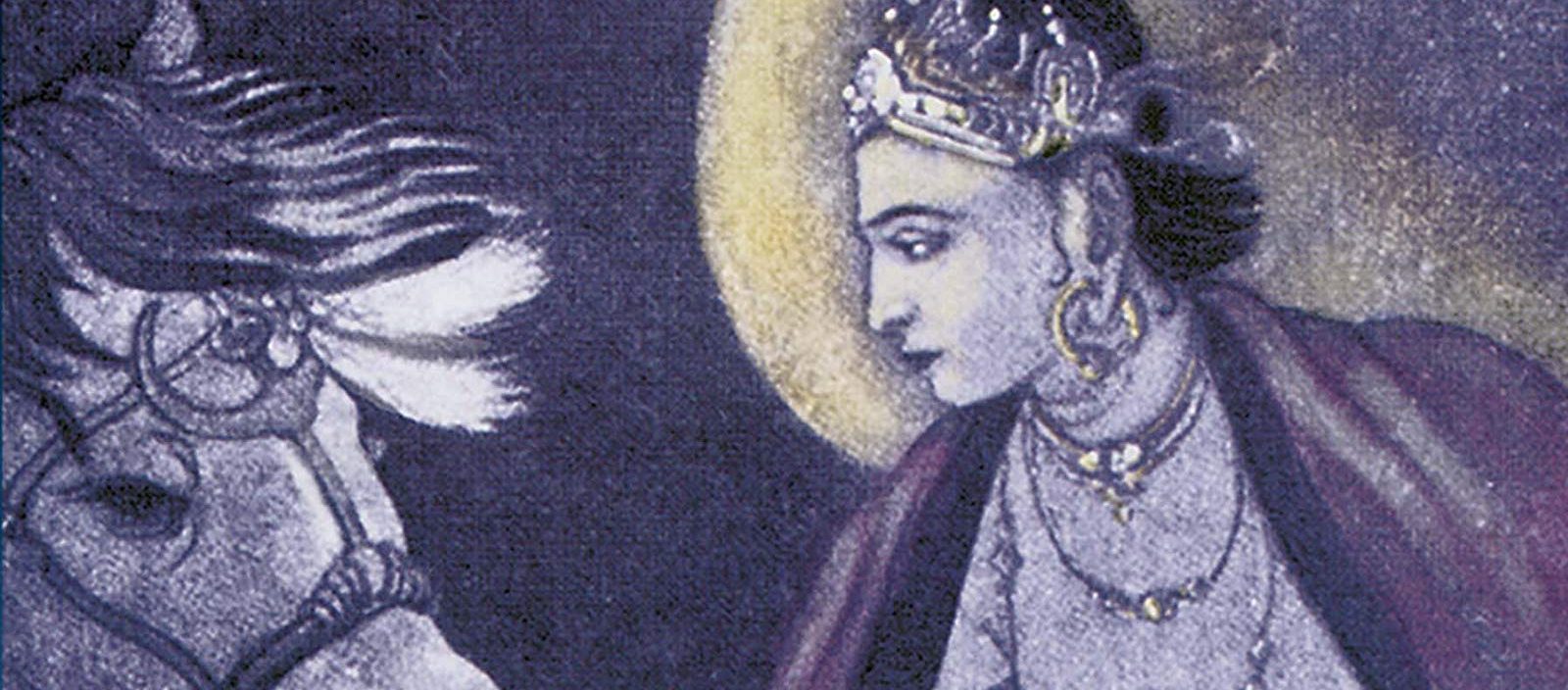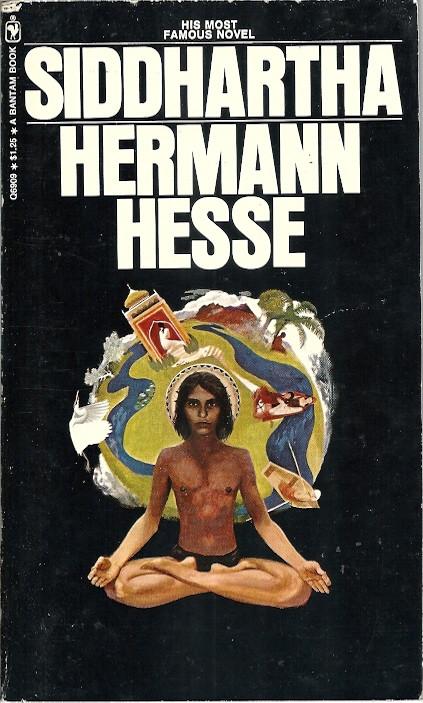

“Wisdom cannot be imparted. Wisdom that a wise man attempts to impart always sounds like foolishness to someone else.”
Siddhartha is about a young man’s quest for self-actualization and spiritual discovery, set during the time of Gautama Buddha. Siddhartha’s various forays into untested waters, from his young adulthood until his twilight years, allow him to learn many lessons from many teachers, but he ultimately discovers that no teacher can instruct him on things that must come from within himself. A lifetime of discernment leads him to eventually find enlightenment by rejecting carnal pleasure and the desire for knowledge and viewing his life as an interconnected whole, each episode—good and bad—necessary upon his path to nirvana.
The story is very simple; the real substance of the book is found in its philosophical digressions. Hesse, a prominent German poet, author, and painter, was dealing with family turmoil and health problems—subjects dealt with in his novels Rosshalde (1916) and Demian (1919)—when he began exploring Eastern spirituality. Much of Hesse’s writing is thinly veiled autobiography—he wrote not to entertain or inform or enlighten (or, at least these were not his primary goals), instead putting pen to paper as a kind of self-therapy. Siddhartha is a result of his interest in Indian culture and philosophy. Drawing on ancient Buddhist teachings and mixing them with his own Protestant upbringing, Hesse’s novel fictionalizes his own attempts at achieving enlightenment.
The novel begins with Siddhartha as a young man. He chooses to leave his father’s house, rejecting the plans for him to follow in his father’s footsteps and become a Brahmin (a Hindu priest); instead, along with his friend Govinda, he becomes an ascetic—a samana—because he believes it is the best way for him to become spiritually enlightened.1 He has been taught not to disobey his father, and waits, standing vigil for an entire night until his father gives him permission to embark on his journey of self-denial. Thus he rejects worldly pursuits and focuses on matters of the soul and mind.
He had begun to surmise that his venerable father and his other teachers, that these wise Brahmins had already conveyed the majority and the best part of their wisdom, that they had already poured out their plenty into his waiting vessel, and the vessel was not full, the mind was not satisfied, the soul was not calm, the heart was not stilled. Ablutions were good, but they were water, they did not wash away sin, they did not quench spiritual thirst, they did not dissolve fear in the heart.
Siddhartha and Govinda spend several years as homeless wanderers, disciplining their bodies and mortifying their fleshly desires. They fast, keep no personal possessions, and meditate intensely for long periods of time. Their desire for enlightenment eventually leads them to seek out the Buddha, a living man who has found enlightenment. Both are swayed by his elegant teachings, but only Govinda decides to join the order of monks. Siddhartha believes that the Buddha’s teachings and philosophy are sound and wise, but that each individual is required to walk a unique, distinct path of self discovery that cannot be explained to them by any human teacher—even the Buddha, himself enlightened, cannot possibly convey his experience in such a way as to lead another to the same destination.
“To no one, o most Venerable One, will you be able to speak and convey in words what happened in the hour of your enlightenment! The teachings of the enlightened Buddha encompass a great deal, they teach much, how to live righteously, how to avoid evil. But one thing the teachings, so clear and so venerable, do not contain: they do not contain the secret of what the Exalted One himself experienced, he alone among the hundreds of thousands.”
Siddhartha experiences a metaphorical rebirth, likening himself to a newborn child, and realizes he does not have a home. He is not a priest, not a nobleman, not a laborer, not a monk, not a hermit; not even a son to his father. He is just Siddhartha, the awakened one.
A goal stood before Siddhartha, a single goal: to become empty, empty of thirst, empty of wishing, empty of dreams, empty of joy and sorrow. Dead to himself, not to be a self any more, to find tranquility with an emptied heart, to be open to miracles in unselfish thoughts, that was his goal. Once all of my self was overcome and had died, once every desire and every urge was silent in the heart, then the ultimate part of me had to awake, the innermost of my being, which is no longer my self, the great secret.
In the second part of the novel, Siddhartha re-enters the world. He falls in love with a courtesan named Kamala whose mouth he likens to a cracked fig. He becomes the business partner of a successful merchant. He finds that he can engage in many worldly activities—business, pleasure, gambling—without giving them a hold on his life; without placing unnecessary value on them. But eventually, he is overcome by the things of the world, and becomes attached to the fleshly desires that he had previously fought so diligently to free himself from. He has become an animal, a slave of his desires, and he briefly contemplates suicide before falling into meditative sleep and experiencing the holy word Om.
Just as a potter’s wheel, once it has been set in motion, will keep on turning for a long time and only slowly lose its vigour and come to a stop, thus Siddhartha’s soul had kept on turning the wheel of asceticism, the wheel of thinking, the wheel of differentiation for a long time, still turning, but it turned slowly and hesitantly and was close to coming to a standstill. Slowly, like humidity entering the dying stem of a tree, filling it slowly and making it rot, the world and sloth had entered Siddhartha’s soul, slowly it filled his soul, made it heavy, made it tired, put it to sleep. On the other hand, his senses had become alive, there was much they had learned, much they had experienced. […] He had been captured by the world, by lust, covetousness, sloth, and finally also by that vice which he had used to despise and mock the most as the most foolish one of all vices: greed. Property, possessions, and riches also had finally captured him; they were no longer a game and trifles to him, but had become a shackle and a burden.
Siddhartha meets a ferryman, and becomes his companion. Vasudeva is a simple man who believes that he has learned all he needs to know from the different voices of the river. One day, Kamala, now a converted Buddhist, is traveling to visit the dying Buddha on his deathbed when she is bitten by a snake. She dies from the venomous bite, and Siddhartha realizes that the child traveling with her is his own son. He tries to raise the boy, but becomes frustrated that the child will make the same mistakes he did. Just as he had understood that the Buddha could not teach him, he realizes that he cannot teach his son everything, that his son must learn for himself, and so he allows him to run away without pursuit.
As Siddhartha and Vasudeva listen to the river, Siddhartha grasps that time is an illusion; that all of his senses, feelings, and experiences—good and bad, happy and sad—are all part of ultimate reality, a harmonious fellowship of all things interconnected in a great natural cycle. With Siddhartha now enlightened, Vasudeva considers his task complete and wanders alone into the forest.
The elderly Siddhartha is visited by his old friend Govinda, who does not recognize him at first. Govinda asks his friend to share some of the wisdom he has gained throughout his life. Siddhartha speaks of the necessity of opposites, the connectedness of everything, and the shortcomings of language. The limitations of words and the confines of time lead people to adopt fixed belief systems that cannot encompass the totality of the truth. Govinda kisses Siddhartha’s forehead and has visions of timelessness just as Siddhartha did when sitting by the river with Vasudeva.
The main idea of Siddhartha seems to be that enlightenment can only be achieved through the life experience of the individual—intellectual pursuits and physical interaction are both inadequate in and of themselves. So while on one hand, no single thing directly leads to nirvana or samsara; on the other, these things cannot be considered diversions, because they lead to experience, which is considered in its completeness as the basis for enlightenment.
The book found success in America when it was translated in the 1950s, appealing to the alienated youth, political misfits, and restless itinerants. The novel’s setting and themes are Buddhist, but several general elements—individualism, the rejection of authority and formal education, communion with all of nature, the immanence of God—hold broader appeal. It seems focused vaguely on the New Age belief in the Law of Attraction—that positive thoughts bring positive experiences to a person’s life, and negative thoughts negative experiences.
I found the ideas difficult to parse at times, because, being a novel, it is not an intentional systematic explanation of a belief system. I am not very familiar with Buddhist teachings, so my feelings toward the book are caught up almost exclusively in the life of Siddhartha and his personal discoveries. That being the case, I found Siddhartha to be a refreshing read. You don’t need to become a tonsured Buddhist monk to take valuable lessons from the Siddhartha—its examples of antimaterialism, asceticism, and mindfulness are broadly applicable and its imploration to pursue self-knowledge and authenticity is legitimate. However, it doesn’t really teach you anything about Buddhism and it does get a little bit carried away with its nonspecific mysticism.
1. Hesse came from a Protestant missionary family, and briefly attended seminary before leaving to pursue a career as a poet.
Sources:
Nobel Lectures, Literature 1901-1967. Editor Horst Frenz, Elsevier Publishing Company, Amsterdam, 1969.
Hermann Hesse – Biographical. NobelPrize.org. Nobel Media AB. 2020.